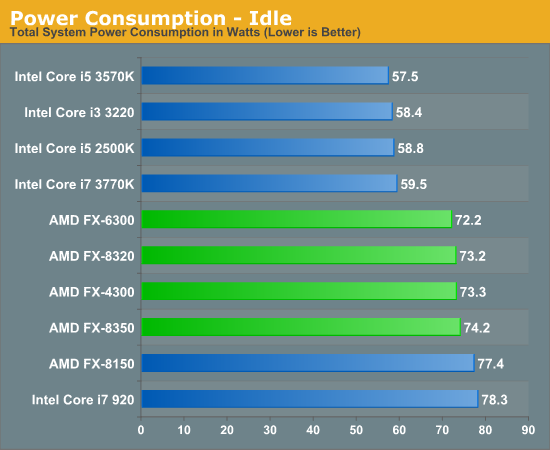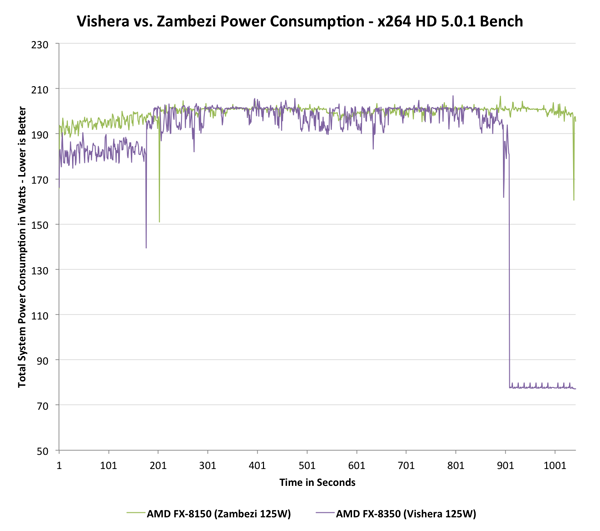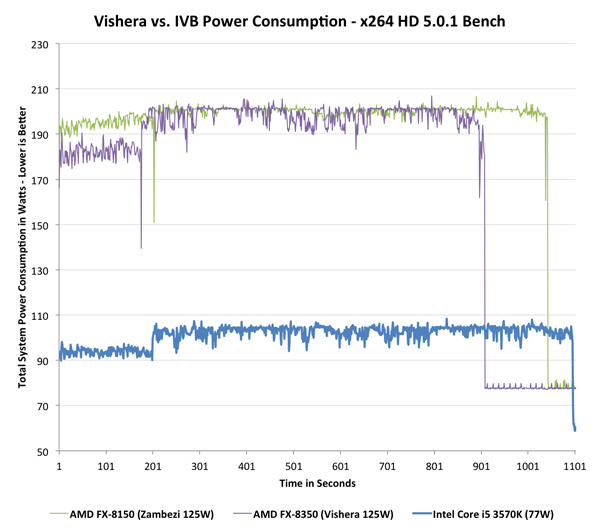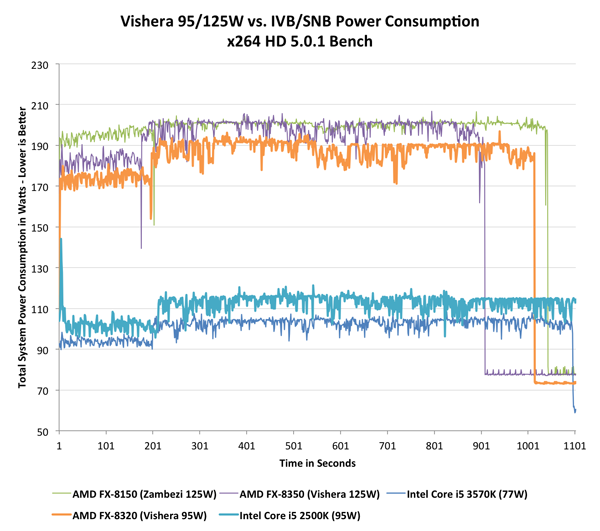The Vishera Review: AMD FX-8350, FX-8320, FX-6300 and FX-4300 Tested
by Anand Lal Shimpi on October 23, 2012 12:00 AM ESTPower Consumption
With Vishera, AMD was in a difficult position: it had to drive performance up without blowing through its 125W TDP. As the Piledriver cores were designed to do just that, Vishera benefitted. Remember that Piledriver was predominantly built to take this new architecture into mobile. I went through the details of what makes Piledriver different from its predecessor (Bulldozer) but at as far as power consumption is concerned, AMD moved to a different type of flip-flop in Piledriver that increased complexity on the design/timing end but decreased active power considerably. Basically, it made more work for AMD but resulted in a more power efficient chip without moving to a dramatically different architecture or new process node.
In mobile, AMD used these power saving gains to put Piledriver in mobile APUs, a place where Bulldozer never went. We saw this with Trinity, and surprisingly enough it managed to outperform the previous Llano generation APUs while improving battery life. On desktops however, AMD used the power savings offered by Piledriver to drive clock speeds up, thus increasing performance, without increasing power consumption. Since peak power didn't go up, overall power efficiency actually improves with Vishera over Zambezi. The chart below illustrates total system power consumption while running both passes of the x264 HD (5.0.1) benchmark to illustrate my point:
In the first pass Vishera actually draws a little less power, but once we get to the heavier second encode pass the two curves are mostly indistinguishable (Vishera still drops below Zambezi regularly). Vishera uses its extra frequency and IPC tweaks to complete the task sooner, and drive down to idle power levels, thus saving energy overall. The picture doesn't look as good though if we toss Ivy Bridge into the mix. Intel's 77W Core i5 3570K is targeted by AMD as the FX-8350's natural competitor. The 8350 is priced lower and actually outperforms the 3570K in this test, but it draws significantly more power:
The platforms aren't entirely comparable, but Intel maintains a huge power advantage over AMD. With the move to 22nm, Intel dropped power consumption over an already more power efficient Sandy Bridge CPU at 32nm. While Intel drove power consumption lower, AMD kept it constant and drove performance higher. Even if we look at the FX-8320 and toss Sandy Bridge into the mix, the situation doesn't change dramatically:
Sandy Bridge obviously consumes more than Ivy Bridge, but the gap between a Vishera and any of the two Intel platforms is significant. As I mentioned earlier however, this particular test runs quicker on Vishera however the test would have to be much longer in order to really give AMD the overall efficiency advantage.
If we look at average power over the course of the two x264 encode passes, the results back up what we've seen above:

As more client PCs move towards smaller form factors, power consumption may become just as important as the single threaded performance gap. For those building in large cases this shouldn't be a problem, but for small form factor systems you'll want to go Ivy Bridge.
Note that idle power consumption can be competitive, but will obviously vary depending on the motherboard used (the Crosshair Formula V is hardly the lowest power AM3+ board available):














250 Comments
View All Comments
Idiot10 - Tuesday, May 7, 2013 - link
Here comes Mr. ChariseHogburn again. the all-knowing Intel mercenary processor expert, who thinks nothing can beat his beloved 2500K. SOB!!!!Got my first AMD - Thursday, May 8, 2014 - link
I OC my 8320 to 4.7 GHz and only have to raise the voltage .0125 from stock. Why is it that you think AMD is worthless. They are all for the consumer and I am grateful for it. I'm really sick of your ignorance. Really sick of it.cbrown - Thursday, June 12, 2014 - link
What everyone will get "sick" of in a hurry is if AMD falls on its face with its "crap" cpu manufacturing... Intel will double their pricing on cpus again, same as they were during the time period AMD released it's "crap" slot athlon 500. AMD also has a decent gpu to fall back on since they bought ATI which was a smart move.*AMD released Slot A Athlon 500 Intel slashed it's prices in half same day to match.
*If ATI hadn't stepped up to the plate and suceeded when nVidia bought 3dfx Everyone would be crying about the prices of gaming cards
*Sure AMD is lagging behind right now but never underestimate the importance of competition and the effect it has on affordable upgrades for everyone...
I love AMD for the pricing they have brought to us this day and time... with cpu's AND gpu's
I am fixing to build my FIRST intel platform since the since amd released the slot a athlon simply because I want a hackentosh... there is simply too much heartache building one on a AMD CPU/MOBO combo for the simple fact apple does not support them. I dont know if you would call me a amd fanboy or not, your opinion, I simply have supported a company that brought affordability to everyone.... I am either MAC (intel, no choice really) or AMD for the windows platform...
Anyone that cannot see the reasoning behind this, now I would say they are a intel fanboy though.... Everyone has the right to choose.....
saintalchemyst - Saturday, July 4, 2015 - link
Watch and relize the fan boy you are. Intel is great at what they do...SO IS AMD! https://www.youtube.com/watch?v=eu8Sekdb-IECaulkWarmer - Wednesday, August 5, 2015 - link
Well I can answer that question for you. It's because we don't need to. I hear Intel fanboys talking about overclocking all the time. Now why is that? Is it because you spent a house payment on your big fancy i7 alone, so now you just have to squeeze in those extra clock cycles? And then here I am, spent 110 bucks on a 8320 on a Newegg sale and what do you know, I don't *need* to overclock. Why would I do something I don't need to do? Well, I'm not a little bitch fanboy afterall so I'll just be happy with what I got and not talk shit about something I have no experience with (take the hint).You know what I am sick of? Hearing people like you bitch and moan about how they hate AMD, on an article *about* AMD. Is your butt hurting you hun? Don't you have some crippled kids you have to go beat? Shoo.
sleekz - Thursday, May 2, 2013 - link
Priced cheaply, but they don't match price/performance wise. Price is not a valid argument against intel.Abdussamad - Monday, August 12, 2013 - link
Do the math on electricity consumption and you find it is not priced decently at all. Let's say you run a system with an idle FX 8350 for 8 hours a day everyday for 5 years and electricity costs you $0.16 per kwh:(( 8 hours * (74.2 - 57.5) * 365 days * 5 years ) / 1000) * 0.16 = $39
(74.2 - 57.5 is the difference in idle power consumption between an fx-8350 and i5-3570)
So add $40 to the price of the FX 8350 before you do a comparison. More if you run your system 24/7.
lostinspacex - Wednesday, November 13, 2013 - link
duuude its 40 dollars in 5 years, you spend more going to a restaurant once , and u are multiplying watts with kilowatts xD, basic math mistakechekk42 - Wednesday, November 13, 2013 - link
Look closer. The math is correct. However, yes, $40 over 5 years is not really a concern.ninza228248 - Monday, April 14, 2014 - link
After 5 years add $40 to AMD and you will get mind blowing processor compared to Intel Core i5-3570 or any intel processor after 5 years in that price bracket...